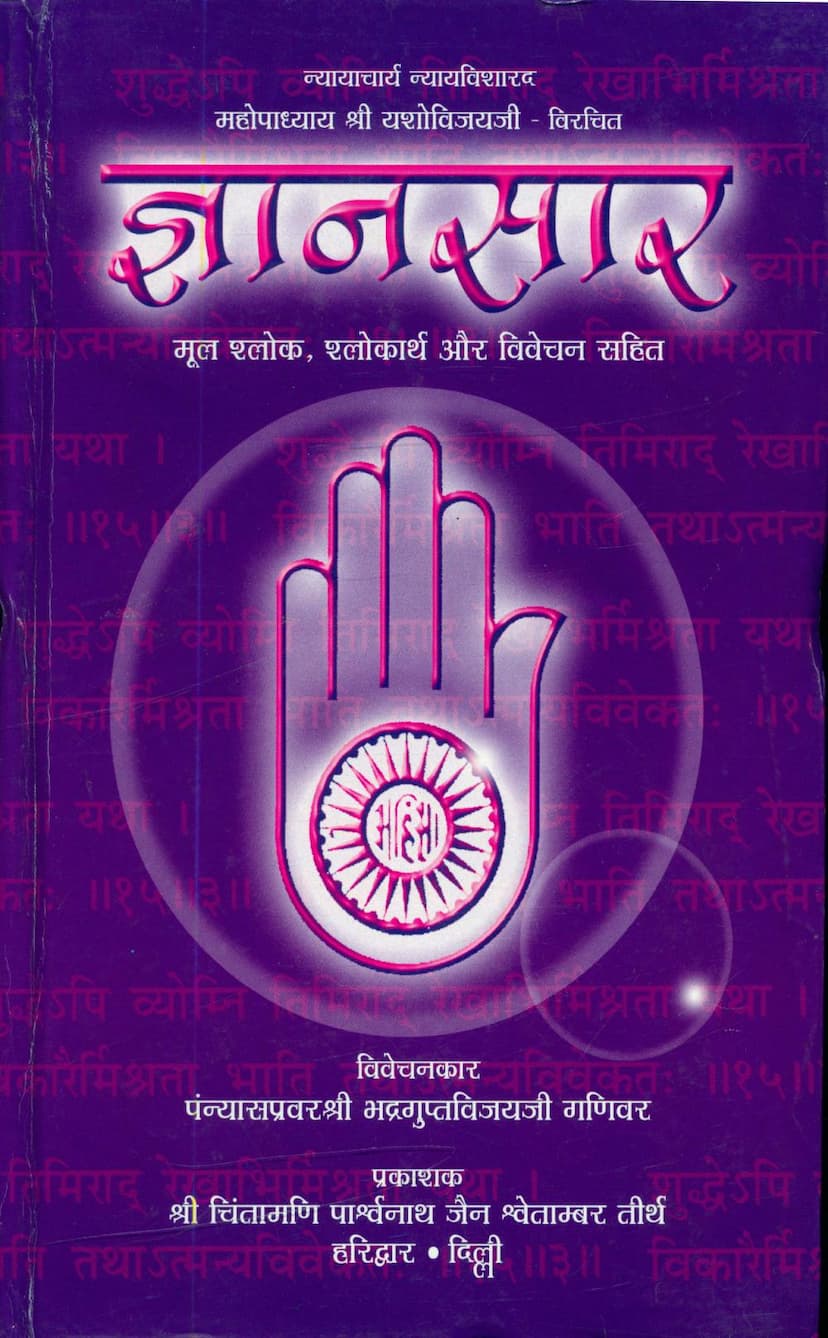Gyansara
Added to library: September 1, 2025

Summary
This Jain text, "Gyansara" by Acharya Shri Vijay Bhadragupta Suriji, with the original verses by Nyayacharya Nyayavisharad Mahopadhyay Shri Yashovijayji, is a profound exposition of Jain philosophy and spiritual practice. Published by Shri Chintamani Parshwanath Jain Shwetambar Tirth, it aims to guide individuals towards spiritual fulfillment and ultimate liberation.
Key Themes and Content:
The book is structured around thirty-two "Ashtakas" (octaves), each focusing on a specific spiritual principle or virtue. These Ashtakas serve as stepping stones, progressing from fundamental concepts to advanced spiritual states. A comprehensive summary of these themes includes:
-
Purnata (Perfection): The text emphasizes the inherent perfection of the soul and the journey from imperfection to achieving that inherent fullness. It contrasts worldly, borrowed perfection with the true, innate perfection of the soul.
-
Magnata (Absorption/Immersion): This principle highlights the importance of complete absorption in knowledge and spiritual practice, detaching from worldly sensory experiences and immersing the mind in the divine essence of the soul.
-
Sthirata (Steadfastness): It stresses the need for mental and emotional stability, the ability to remain undisturbed by external circumstances, and unwavering focus on the spiritual path.
-
Amoha (Non-attachment/Freedom from Delusion): This section delves into overcoming worldly attachments, illusions, and misconceptions that bind the soul to the cycle of birth and death.
-
Gyan (Knowledge): The true nature of knowledge is explored, distinguishing between superficial knowledge and the profound self-knowledge that leads to liberation.
-
Sham (Tranquility/Equanimity): The importance of inner peace, mental stillness, and maintaining an even temper, regardless of external stimuli, is emphasized.
-
Indriyajay (Victory over Senses): This principle focuses on conquering the senses and controlling their desires, which are seen as major obstacles on the spiritual path.
-
Tyag (Renunciation): The text discusses various levels of renunciation, from external possessions to internal attachments and desires, as a means to spiritual progress.
-
Kriya (Action/Practice): It clarifies the role of righteous actions and practices in spiritual discipline, emphasizing that mere knowledge without practice is insufficient.
-
Tripti (Contentment): The concept of true contentment is explored, differentiating it from fleeting worldly pleasures and highlighting the deep satisfaction derived from spiritual realization.
-
Nirlepata (Non-attachment/Unstained): This theme focuses on remaining unaffected by worldly experiences, maintaining purity of the soul even amidst the challenges of life.
-
Nihsprihata (Non-desire/Contentment): It emphasizes detachment from desires and aspirations, finding contentment within the self.
-
Maun (Silence/Stillness): The text explores the power of inner silence and stillness, both external and internal, as a means to connect with the higher self.
-
Vidya (True Knowledge): It distinguishes true spiritual knowledge from worldly knowledge, highlighting the transformative power of self-realization.
-
Vivek (Discrimination): The importance of the ability to discern between the eternal self (soul) and the transient world (matter) is crucial for spiritual progress.
-
Madhyastha (Neutrality/Impartiality): This principle advocates for a balanced and unbiased approach towards all beings and situations, free from attachment or aversion.
-
Nirbhayata (Fearlessness): Overcoming fear and cultivating inner courage is presented as essential for spiritual advancement.
-
Anatmashansa (Self-Praise/Eulogy): The text warns against self-praise and ego, emphasizing humility and the recognition of true virtues.
-
Tattva-drishti (Vision of Reality): It stresses the importance of seeing things as they truly are, penetrating beyond superficial appearances to grasp the underlying reality.
-
Sarva-samriddhi (All-round Prosperity): This theme encompasses spiritual, intellectual, and inner prosperity, achieved through self-discipline and righteous conduct.
-
Karmavipaka-Chintan (Reflection on the Fruits of Karma): The text elaborates on the principle of karma and its consequences, urging mindfulness of actions and their repercussions.
-
Bhava-udveg (Mental Agitation/Distress): It addresses the causes of mental agitation and offers remedies for achieving mental peace.
-
Loka-Sangya-Tyag (Abandonment of Worldly Notions): This principle encourages detachment from worldly opinions, societal pressures, and conventional expectations.
-
Shastra (Scriptures): The paramount importance of scriptures as a guide for spiritual knowledge and practice is highlighted.
-
Parigraha-Tyag (Renunciation of Possessions): It details the principles of non-possession, both external and internal, as a path to freedom.
-
Anubhav (Experience): True spiritual understanding comes from direct experience, not just intellectual knowledge.
-
Yoga: The text outlines various yogic practices and their role in achieving spiritual union.
-
Niyaga (Ritual/Yajna): It reinterprets rituals and sacrifices in a spiritual context, emphasizing inner devotion over external rituals.
-
Bhavapuja (Inner Worship): The paramount importance of internal worship and devotion, rather than mere external rituals, is stressed.
-
Dhyana (Meditation): The book provides guidance on meditation as a means to connect with the inner self and achieve mental tranquility.
-
Tapa (Austerity): It discusses the significance of austerities, both external and internal, in purifying the soul and weakening karmic bonds.
-
Sarvanaya-Ashraya (Dependence on All Perspectives): This concluding principle emphasizes the importance of understanding various viewpoints and integrating them for a holistic spiritual perspective, ultimately leading to the realization of the ultimate truth.
Overall Message:
"Gyansara" is a comprehensive guide for spiritual seekers, offering a systematic approach to understanding the self, overcoming obstacles, and ultimately achieving the highest spiritual state. It is a text that blends philosophical depth with practical guidance, making the profound teachings of Jainism accessible and relevant for personal growth and spiritual liberation. The emphasis is on self-effort, inner transformation, and the pursuit of true knowledge and detachment.